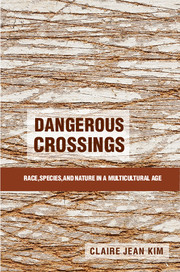Book contents
2 - Animals, Nature, and the Races of Man
Published online by Cambridge University Press: 05 April 2015
Summary
Race as a natural-technical object of knowledge is fundamentally a category marking political power through location in “nature.”
– Donna Haraway, Primate VisionsRacialized groups have been likened to animals for centuries in Western culture, and because such comparisons have enabled extreme violence, they are considered today to be “dreaded” or even “inadmissible.” The conventional wisdom is that powerful groups have used animalization to “dehumanize” less powerful groups, demoting them from category A (humans) into category B (animals) and thus stripping them of the entitlements, rights, and protections distinctively owed to humans. Of course, this argument assumes an a priori state in which racialized groups were accepted as fully human. I argue in this chapter that racialized groups were never seen as fully human to begin with, so they did not have this status to lose. They were always already animal or animal-like. Animality and nature have been integral not incidental to the production of racial difference (Haraway 1989). Constructed in intimate relationship with animals and nature, Blacks, Indians, and the Chinese in the United States have been located for centuries in a borderlands between human and animal, a fraught zone of ambiguity, menace, and transgression.
As a taxonomy of power, race lumps and splits. First, it places all nonwhites into a borderlands between human and animal. The concept of “borderlands” can mean an area around a border and/or an indeterminate area where units overlap, that is, an area demarcated by borders or an area that gives borders the lie. Here I use it to suggest an imaginative space where both liminal humans and the most human-like animals are located – testimony to both humans’ powerful drive to distinguish themselves hierarchically from other humans and animals and their failure to do so in any permanently successful way. It is a space wrought by power but illustrative of power’s indeterminacy. Whites, seen as quintessentially human, have never been located in this borderlands – they transcend the body and nature, they are progressive, they move forward through history, they have civilization and a history. Animals and animal-like humans, on the other hand, are untranscendent, tethered to the body and nature, incapable of civilization and progress, and lacking history.
- Type
- Chapter
- Information
- Dangerous CrossingsRace, Species, and Nature in a Multicultural Age, pp. 24 - 60Publisher: Cambridge University PressPrint publication year: 2015
- 1
- Cited by



